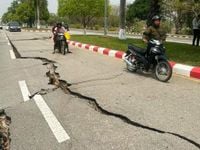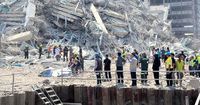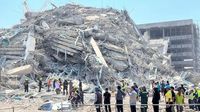On Friday, March 28, 2025, a devastating series of earthquakes struck Myanmar and were felt across the region, including in Thailand, where a high-rise construction site collapsed, trapping dozens of workers. The United States Geological Survey (USGS) reported a magnitude 7.7 earthquake, followed by a 6.4 magnitude aftershock, with the epicenter located 16 kilometers northwest of Sagaing, Myanmar, at a depth of 10 kilometers (6 miles). The tremors began at approximately 12:50 PM local time (06:20 GMT).
In Myanmar, the impact was immediate and severe. The ruling military declared a state of emergency across six regions and states, signaling a swift response to the unfolding crisis. Reports indicate at least three fatalities from a mosque that partially collapsed in the town of Taungnoo, located in the Bago region. A witness recounted the harrowing moment, stating, “We were saying prayers when the shaking started… Three died on the spot.”
As hospitals braced for an influx of casualties, a major medical facility in Naypyidaw was designated a "mass casualty area," with rows of injured individuals receiving treatment outside the emergency department. Witnesses described the scene as chaotic, with many victims writhing in pain while family members tried to provide comfort.
Social media footage from Mandalay, Myanmar's ancient royal capital, depicted scenes of destruction, with collapsed buildings and debris strewn across the streets. Al Jazeera's Tony Cheng, who was in Naypyidaw at the time of the quake, detailed the intensity of the tremors, saying, "I’ve been in earthquakes in this region before, and I’ve never felt anything as strong as that.” Cheng and others sought shelter as large roofing and side panels crashed down around them.
In the neighboring country of Thailand, the earthquake's effects were equally alarming. Residents in Bangkok rushed out of high-rise buildings as the tremors shook the city. The entire public transport system was halted for safety reasons, leading to significant traffic congestion throughout the capital. Reports emerged of a 30-story skyscraper under construction in the Chatuchak area collapsing, trapping at least 43 construction workers beneath the rubble. Thai emergency responders confirmed that two bodies had been recovered, while seven individuals were found alive. The fate of many others remains uncertain.
Thai Prime Minister Paetongtarn Shinawatra declared a state of emergency in Bangkok, emphasizing the need for a coordinated disaster response. The Bangkok governor has been tasked with overseeing rescue efforts, as inspections of damaged buildings began immediately. Governor Chadchart Sittipunt remarked on the widespread structural damage, urging caution among residents.
The tremors were also felt in China, specifically in the provinces of Yunnan and Sichuan, where damage to homes in the city of Ruili was reported. Videos from the area showed debris scattered across streets and emergency responders attending to injured individuals.
Historically, earthquakes are not uncommon in Myanmar, particularly around the Sagaing Fault, where previous significant quakes have occurred. A notable incident in 2016 saw a 6.8-magnitude earthquake in Bagan, resulting in three fatalities and damage to the region's famous temples.
Al Jazeera's Cheng highlighted the ongoing challenges facing Myanmar, which is currently embroiled in a civil war. The conflict has led to increased urban migration, resulting in crowded cities where building standards may not be adequate to withstand such seismic events. "A lot of the people have moved from the countryside into the cities to try and escape," he noted, adding that this has contributed to the risk of structural failures during earthquakes.
As the situation continues to develop, both Myanmar and Thailand are grappling with the immediate aftermath of these earthquakes. The Thai stock exchange announced a temporary halt in operations following the quake, reflecting the broader economic implications of the disaster.
In a show of solidarity, Indian Prime Minister Narendra Modi stated that India is prepared to offer assistance to both Myanmar and Thailand in their recovery efforts. As rescue operations unfold, the focus remains on locating survivors and assessing the full extent of the damage.
With the region still reeling from the impact of these powerful earthquakes, authorities in both countries are working tirelessly to address the humanitarian needs of those affected. The full toll of the disaster remains unclear, but the urgency of the situation is palpable as communities come together to support one another during this challenging time.






